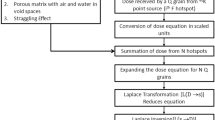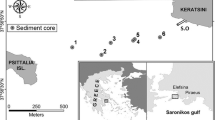Abstract
In Ge gamma-ray spectrometry for the annual radiation dose determination in the luminescence dating of sediments, the picture of 226Ra enrichment or depletion (in the 238U decay series) obtained via measurement of its 214Pb and 214Bi daughters may be disturbed by the 222Rn-content of the sample being decreased due to manipulations such as drying and pulverizing. Therefore, it is common practice to start the measurement only about 1 month after encapsulating the material, after which the 226Ra(1600 a)- 222Rn(3.82 d) mother-daughter equilibrium is re-established. Evidently, this only holds on condition that no significant escape of Rn occurs out of the sediment after making it up for counting. In order to experimentally investigate this effect, in the present work measurements were carried out with various types of dried and pulverized sediments that were either encapsulated in screw-cap polystyrene vials or in sealed glass containers, or that were mixed with molten wax followed by solidification in a cylindrical geometry. From the results obtained, it could be concluded that preparation and counting of the sediment-wax mixture is the method of choice.
Similar content being viewed by others
References
Aitken M. J.: Thermoluminescence Dating, Academic Press, New York (1985).
Hossain S.M., De Corte F., Vandenberghe D. and Van den Haute P.: Nucl. Instr. Methods A 490 (2002) 598.
IAEA: Preparation and Certification of IAEA Gamma Spectrometry Reference Materials RGU-1, RGTh-1 and RGK-1, Report IAEA/RL/148 (1987).
Adamiec G. and Aitken M.: Ancient TL 16 (1998) 37.
De Corte F., Umans H., Vandenberghe D., De Wispelaere A. and Van den haute P.: Appl. Radiat. Isotopes 63 (2005) 589.
Murray A.S., Marten R., Johnston A. and Martin P.: J. Radioanal. Nucl. Chem. 115 (1987) 263.
Murray A.S. and Aitken M.J.: Appl. Radiat. Isotopes 39 (1988) 145.
Krbetschek M.R., Rieser U., Zöller L. and Heinicke J.: Radiation Measurements 23 (1994) 485.
Fazekas B., Molnár G., Belgya T., Dabolczi L. and Simonits A.: J. Radioanal. Nucl. Chem. 215 (1997) 271.
De Corte F., Vandenberghe D., Hossain S.M., De Wispelaere A. and Van den haute P.: J. Radioanal. Nucl. Chem. 262 (2004) 261.
Deckers K.: personal communication.
De Corte F., Dejaeger M., Hossain S.M., Vandenberghe D., De Wispelaere A. and Van den Haute P.: J. Radioanal. Nucl. Chem. 263 (2005) 659.
Kayzero/Solcoi, software for using the k0-standardization method, V. 5A. University of Ghent and DSM Research, Geleen (2003).
Author information
Authors and Affiliations
Rights and permissions
About this article
Cite this article
De Corte, F., Vandenberghe, D., De Wispelaere, A. et al. Radon loss from encapsulated sediments in Ge gamma-ray spectrometry for the annual radiation dose determination in luminescence dating. Czech J Phys 56, D183–D194 (2006). https://doi.org/10.1007/s10582-006-1016-3
Issue Date:
DOI: https://doi.org/10.1007/s10582-006-1016-3




